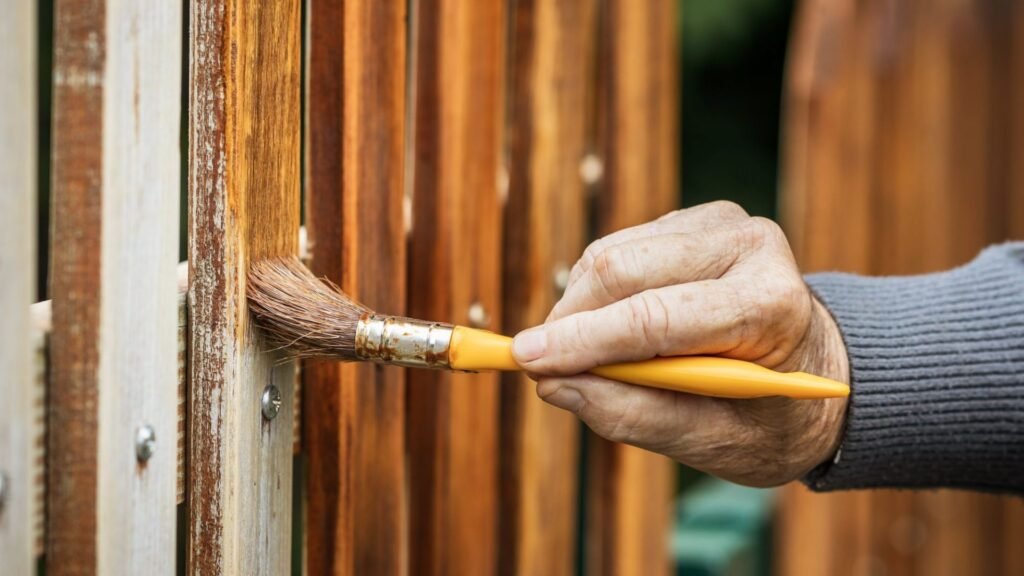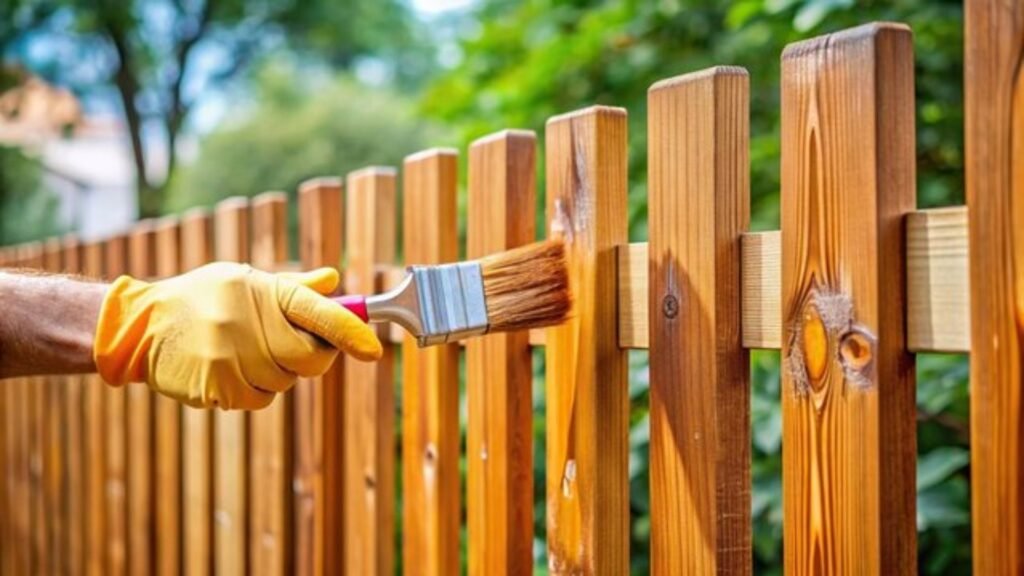Welcome to our guide on the common question, “Can I paint my side of my neighbor’s fence?” If you’ve been considering giving your backyard a fresh new look or just tidying up the appearance of a shared fence, you might be wondering where you stand when it comes to property rights and fence ownership. While it may seem like a simple task, painting your side of the fence can bring up legal and neighborly concerns that need careful consideration. In this post, we’ll dive into everything you need to know—from legal aspects and communication tips with your neighbor, to paint options and alternative solutions—so you can make an informed decision that keeps both the fence and your neighborly relations in great shape.
Yes, you can paint your side of your neighbor’s fence, but only with their permission if they own the fence. It’s important to check property boundaries and local laws first. Even if the fence is shared or you own it, maintaining good communication with your neighbor is crucial to avoid disputes. Always get written consent and consider neutral paint colors to keep the peace.
Table of Contents
Understanding Fence Ownership And Boundaries
When it comes to installing, maintaining, or replacing a fence on your property, understanding fence ownership and boundaries is essential. Not only does it help avoid disputes with neighbors, but it also ensures compliance with local laws and regulations. Below, we’ll dive into key aspects such as determining who owns the fence, how local laws influence fence boundaries, and why it’s important to clear up common misconceptions.
Who Owns the Fence?
One of the most common questions homeowners face is, “Who owns the fence between two properties?” In most cases, the responsibility of maintaining or repairing a fence depends on property lines and specific agreements between neighbors. Here’s how to approach the issue of fence ownership:
1. Checking the Deeds and Land Surveys
The most reliable way to determine who owns a fence is by reviewing the property deeds or conducting a land survey. These documents provide a legal description of where property lines fall, as well as any specific agreements about boundary fences. This step is crucial before making any decisions regarding fence construction, repair, or alteration.
2. Common Boundary Rules (Left vs. Right)
In some areas, there are general conventions about fence ownership. For instance, in the UK, there’s a widespread belief that the homeowner is responsible for the fence on the left side of their property. However, this “rule” can vary greatly by location and may not hold up legally. In the U.S., ownership is less standardized, so checking your legal property documents is always the safest bet.
3. The “Good Side vs. Bad Side” Myth
A commonly held belief is that the neighbor who faces the “good side” of a fence (i.e., the finished side) owns it, while the one facing the “bad side” (the side with posts or rails) is off the hook. This myth doesn’t always reflect reality. While it’s true that fences are often designed with a more finished appearance facing outward toward neighbors or the street, it doesn’t necessarily mean that person is responsible for the fence. It’s important to verify ownership through official documentation rather than relying on this visual cue.
Local Laws and Regulations
Beyond understanding ownership, it’s crucial to be aware of the local laws and regulations that apply to fences. These can vary significantly depending on where you live, and failing to adhere to them could result in fines or disputes. Here’s what you need to know:
1. Importance of Researching Local Laws
Property laws related to fences are not one-size-fits-all. In many regions, local governments or homeowners’ associations (HOAs) have specific regulations about where fences can be placed, their height, and even their design. Before you make any changes to your fence or install a new one, take the time to research these rules. A good place to start is your local municipal code or HOA bylaws.
2. Examples of Variations by Region or Country
In the United States, regulations on fences can differ drastically from one municipality to another. For example, in suburban areas, fences over a certain height may require special permits, while rural areas may have more lenient restrictions. In the UK, there are specific laws related to “party walls” and “party fences” that affect ownership and responsibility. This variation highlights the importance of understanding your local context before making any decisions.
3. Penalties for Violating Fence Regulations
If you violate local fence laws, you may face penalties, and these can range from fines to being forced to make costly repairs or modifications. For instance, installing a fence that is too tall or not conforming to local design standards might lead to a citation. In some cases, you could be asked to repaint or remove a fence entirely if it violates the local rules. Additionally, disputes with neighbors over unapproved modifications can lead to legal action or ongoing neighborhood tensions.
Understanding fence ownership and boundaries is key to avoiding potential conflicts and ensuring that any fencing on your property is compliant with local regulations. Whether you’re unsure about who owns a fence, or what the legal requirements are in your area, taking the time to do your research can save you from headaches down the road. Always verify ownership through deeds and surveys, familiarize yourself with local laws, and never rely solely on myths or assumptions. Taking these steps will ensure that you enjoy a well-maintained fence without unexpected surprises.

Can You Legally Paint Your Side?
When it comes to property boundaries, particularly shared fences, it’s common to wonder whether you’re allowed to paint your side. However, the answer isn’t as straightforward as grabbing a paintbrush. It’s essential to understand the legalities involved to avoid potential disputes with your neighbor. This section dives into the specifics of ownership rights, the necessity of seeking permission, and when it’s acceptable to make changes without asking.
Clarifying Legal Ownership Rights
The first step in determining whether you can paint your side of the fence is to clarify who owns the fence. Ownership plays a crucial role in deciding what you can and cannot do. Here’s a breakdown of common scenarios:
If the Fence Belongs to Your Neighbor
If your neighbor owns the fence, you cannot alter or paint it without their explicit permission. Even though the fence might be on or near the boundary line, it’s still considered their property, and modifying it without consent could lead to disputes. In such cases, always check the property line and confirm who legally owns the fence before proceeding.
If the Fence is Shared
Shared fences, often referred to as “party fences,” are typically owned by both neighbors. In this scenario, any alterations, including painting, require mutual consent. Both parties need to agree on the changes, as each has equal ownership rights. Before making any decisions, open a dialogue with your neighbor to ensure you’re on the same page. A shared fence should reflect the agreement and preferences of both property owners.
Seeking Permission
If you discover that the fence belongs to your neighbor or is shared, the next step is seeking permission. It’s essential to obtain written permission before making any modifications. This helps in multiple ways:
Avoid Disputes
Getting written consent from your neighbor protects you from potential disagreements or legal issues down the road. If your neighbor isn’t pleased with the changes or claims you didn’t have the right to alter the fence, the written agreement serves as proof that you acted within their approval.
Prevent Future Complications
If you ever decide to sell your home, any disputes or unresolved issues regarding boundary fences could complicate the sale process. Having clear documentation that shows both parties agreed on modifications can prevent such complications.
Here are a few polite phrases you can use when approaching your neighbor about painting the fence:
- “Hi [Neighbor’s Name], I’ve been thinking about giving the fence a fresh coat of paint. Since it belongs to you, I wanted to check if you would be open to discussing this and potentially giving me permission.“
- “I was hoping to update my side of the fence and wanted to get your input before proceeding. Would you be comfortable with me painting it?“
- “Would you mind if I painted the side of the fence facing my property? I thought I’d check with you first since it’s important that we agree on any changes.“
By approaching the situation diplomatically and respectfully, you increase the likelihood of receiving a positive response.
When You Can Paint Without Asking
If you are the sole owner of the fence, you have full control over how it looks. However, it’s essential to confirm that the fence is indeed on your property and that you have legal ownership before making changes. You can verify this by checking your property deed or consulting a surveyor to clearly define property lines.
Confirming Ownership
Ensuring you have complete ownership of the fence gives you the freedom to paint it as you see fit. However, it’s wise to double-check any neighborhood regulations or homeowner association (HOA) rules that might restrict certain colors or modifications.
Even if you own the fence and have the legal right to modify it, maintaining a good relationship with your neighbor is always important. While you don’t legally need to ask for permission, informing your neighbor about your plans is a considerate gesture that can help avoid misunderstandings or tension.
Communicating with Your Neighbor
Even if you don’t need their consent, it’s always a good idea to mention your plans. A simple heads-up can prevent potential conflicts. For example, you might say, “Just wanted to let you know that I’m planning to paint my side of the fence next week. If you have any concerns, feel free to let me know!”
By being open and communicative, you show respect for your neighbor’s perspective, which can go a long way in fostering a positive relationship.
The key takeaway when it comes to painting your side of the fence is understanding the ownership and the importance of communication. If you don’t own the fence, always seek permission from your neighbor before making changes. Even when you own the fence, it’s courteous to inform your neighbor to maintain a harmonious relationship. By following these steps, you’ll avoid unnecessary conflicts and ensure that your property remains both aesthetically pleasing and legally compliant.

Maintaining Good Neighbor Relations
When you’re planning a home improvement project that involves shared spaces or visible boundaries, like painting a fence, it’s essential to consider how it might impact your neighbors. Maintaining good neighborly relations not only makes the project smoother but also ensures a positive community atmosphere. Here, we’ll explore key steps to ensure smooth communication, handle potential objections, and resolve conflicts effectively when discussing fence painting with your neighbor.
The Importance of Communication
Good communication is the cornerstone of any neighborly relationship, especially when you’re planning a project that affects shared or visible property. Engaging your neighbor with clear, friendly communication can prevent misunderstandings or conflicts from arising.
- Be upfront and transparent: It’s best to inform your neighbor early about your intention to paint the fence. This way, you give them a chance to voice any concerns before the work begins.
- Explain your reasoning: Whether it’s about aesthetics or maintenance, explaining why you want to paint the fence can help your neighbor understand your perspective. Mention how a freshly painted fence can enhance the curb appeal of both properties, or how it might help protect the wood from weather damage.
- Offer to share the cost: One way to build goodwill is by offering to split the cost of the project, especially if the fence is on a shared boundary. This gesture shows that you value their opinion and are willing to cooperate.
By approaching the conversation with openness, you’re likely to create a foundation of trust and collaboration, helping to avoid unnecessary friction.
Handling Potential Objections
Even with the best intentions, your neighbor might have concerns about your fence-painting project. It’s important to listen and address their objections diplomatically. Here are some common issues that could arise and how to handle them:
- Aesthetic preferences: Your neighbor might be concerned that the color you’re choosing for the fence won’t align with their taste or the look of their property. To alleviate this concern, offer to use a neutral color that blends with both properties. This shows you’re considerate of their preferences while still moving forward with your project.
- Concerns about the quality of paint: Some neighbors may worry about the quality of the materials being used, fearing that the paint might not last or could cause damage over time. Reassure them by selecting high-quality, weather-resistant paint and providing them with information on the products you’re planning to use. Offering to show them the brand or inviting them to inspect the materials can go a long way in easing their concerns.
- Damage to their property: If part of the fence is close to their plants or landscaping, your neighbor might fear accidental damage. To address this, ensure them that you will take precautions, such as covering plants or using barriers to protect their property during the painting process.
By listening to their concerns and offering practical solutions, you can turn potential objections into opportunities for collaboration.
Conflict Resolution Tips
Sometimes, despite your best efforts, you may encounter a situation where your neighbor refuses permission or remains unhappy with the proposal. In these cases, it’s important to handle the situation tactfully to avoid escalating tensions.
- What to do if your neighbor refuses permission: If your neighbor outright refuses to allow the fence painting, it may be worth revisiting the conversation after some time. They could be reacting out of initial hesitation, and a calm, polite follow-up might change their mind. Be patient, and avoid pushing too hard, as this could damage the relationship.
- Mediation options for serious disputes: If the disagreement turns into a more serious conflict, consider third-party mediation. This is especially helpful if the fence is a shared property. Mediators can help both parties reach an agreement in a neutral and fair manner, preventing further escalation.
- Avoiding future issues: To prevent similar disputes down the road, maintain clear property boundaries and make a habit of open communication with your neighbor. This can help ensure that any future projects, like landscaping or repairs, are discussed amicably in advance.
Remember, maintaining good neighbor relations is about more than just solving the problem at hand; it’s about fostering an ongoing positive relationship. Being respectful, understanding, and willing to compromise can make all the difference, ensuring both you and your neighbor are happy with the outcome.
Taking a proactive approach to communication, addressing concerns diplomatically, and resolving conflicts with care can lead to a successful project and a lasting neighborly bond.

Choosing The Right Paint And Colors
When it comes to painting your outdoor fence, selecting the appropriate type of paint and colors is crucial. Not only does it enhance the overall appearance of your property, but it also ensures the fence’s longevity and can contribute to a harmonious neighborhood. Let’s dive into the key aspects you should consider before picking up that paintbrush.
Types of Paint for Outdoor Fencing
Choosing the right type of paint for your outdoor fence can make all the difference in the durability and appearance of your fence over time. Outdoor fences are constantly exposed to harsh elements, from UV rays to rain and wind, so it’s essential to opt for paints specifically designed for outdoor use. Here are the most common options:
- Oil-Based Paints: These are often recommended for outdoor surfaces due to their long-lasting durability and resistance to harsh weather conditions. Oil-based paints create a strong, waterproof seal that protects your fence from moisture, preventing issues like wood rot and rust on metal fences. However, they can take longer to dry and tend to have higher VOC (Volatile Organic Compounds) emissions, which some homeowners may want to avoid.
- Water-Based (Latex) Paints: Water-based paints are a popular choice for their ease of use, quick drying time, and low odor. They are also more eco-friendly, with lower VOC levels than oil-based paints. Though they may not offer the same level of weather resistance as oil-based paints, modern water-based formulations have improved significantly, providing good protection and durability for most climates.
- Acrylic Paints: Acrylic paints are a great middle ground between oil-based and water-based options. They offer excellent UV resistance, which helps prevent fading over time, and can expand and contract with temperature changes, reducing the risk of cracks or peeling. This makes them ideal for regions with fluctuating weather.
- Stains vs. Paints: In addition to traditional paints, you may want to consider wood stains. Stains penetrate the wood, highlighting its natural grain, while still offering protection from the elements. They generally require less maintenance than paint, though they don’t come in as wide a variety of colors.
When choosing the type of paint, it’s crucial to consider the climate you live in and the material of your fence. A high-quality, weather-resistant paint will ensure that your fence stays looking great and remains protected for years to come.
Color Considerations
Choosing the right color for your fence is more than just a matter of personal taste. A fence serves as part of your property’s exterior aesthetic, so its color should blend well with your home’s design, landscaping, and even the neighborhood.
- Neutral and Classic Tones: Neutral colors like whites, beiges, grays, and browns are safe and versatile choices. These colors tend to complement various architectural styles and landscapes, giving your property a clean, polished look. Moreover, neutral tones are less likely to clash with your neighbors’ color schemes, reducing the potential for conflicts about aesthetics in tightly knit communities.
- Bold and Statement Colors: If you prefer to make a statement, darker shades like navy blue, charcoal, or deep green can add depth and sophistication to your fence. However, it’s important to ensure that bolder colors align with your home’s overall design. A striking color choice might be appealing initially, but it could lose its charm over time or become outdated.
- Coordination with Outdoor Design Schemes: It’s also worth considering your outdoor design scheme when selecting a color. For example, if your backyard has a lot of natural elements, such as trees or a garden, earthy tones like greens, browns, and tans can help your fence blend seamlessly with the environment. Alternatively, if you have modern outdoor furniture or hardscaping, choosing contemporary colors like sleek blacks or muted grays can enhance your fence’s visual appeal.
When in doubt, it’s always a good idea to check with neighbors or homeowner associations (HOAs) regarding any color restrictions or preferences to maintain neighborhood harmony.
Environmentally Friendly Paint Options
In today’s environmentally conscious world, many homeowners are looking for ways to reduce their carbon footprint, and choosing eco-friendly paint is an excellent way to contribute to a greener future. Eco-conscious paints not only help reduce pollution but can also improve the air quality around your home.
- Low-VOC and Zero-VOC Paints: VOCs are chemicals that evaporate into the air as the paint dries, contributing to air pollution and potential health risks like headaches, nausea, and respiratory issues. Low-VOC and zero-VOC paints are formulated to reduce these harmful emissions, making them a healthier choice for both your family and the environment. These paints are available in various finishes and colors, offering an eco-friendly option without sacrificing quality or style.
- Natural Paints: If you’re looking to take it a step further, consider natural paints made from renewable resources such as clay, milk, or lime. These paints are completely free from synthetic chemicals, making them biodegradable and even safer for the environment. Though they may come with a higher price tag, the health benefits and reduced environmental impact can be well worth the investment.
- The Benefits of Eco-Friendly Paints: Using environmentally friendly paint has several advantages. Beyond the immediate health benefits of reduced toxic exposure, these products help decrease the carbon footprint of your renovation project. Additionally, they contribute less to smog formation and the depletion of the ozone layer, aligning your home improvement efforts with broader sustainability goals.
Whether you’re focused on protecting the planet, your family’s health, or simply creating a beautiful outdoor space, eco-friendly paint options provide a responsible way to achieve long-lasting, beautiful results without compromise.
Choosing the right paint and colors for your outdoor fence is an important decision that impacts both the look and longevity of your fence. By selecting durable, weather-resistant paint and opting for neutral or complementary colors, you’ll enhance your property’s curb appeal while maintaining a good relationship with your neighbors. Moreover, by considering eco-friendly options, you’re doing your part to protect the environment and promote a healthier living space. So take your time, explore your options, and invest in quality paint to enjoy a beautiful, lasting fence for years to come.

The Painting Process
When it comes to maintaining the beauty and longevity of your fence, a fresh coat of paint can make all the difference. But to ensure a smooth and professional finish, it’s important to follow a careful process. In this section, we’ll walk you through everything from prepping your fence to the final brushstroke, helping you avoid common mistakes and achieve the best results.
Preparation and Priming – Setting the Stage for Success
Before you can dive into the painting process, proper preparation is essential. This stage not only ensures the paint adheres well but also prevents future peeling and flaking. Here’s how to get your fence ready:
1. Clean the Surface: Begin by removing dirt, mold, and debris from the fence. Use a pressure washer or a scrub brush with a mixture of water and mild detergent. This step is crucial, as paint won’t stick properly to a dirty surface.
2. Sanding: Once the fence is dry, sand the surface lightly. Sanding helps to smooth out any rough spots and creates a surface that the paint can grip. Pay special attention to peeling or cracked areas from previous paint jobs.
3. Apply Primer: Primer is your secret weapon for a durable, even finish. It helps the paint stick better and provides a uniform base. Make sure to choose a primer that’s suitable for outdoor wood or whatever material your fence is made of. Apply one or two coats, allowing it to dry thoroughly between applications.
4. Protect Plants and Landscaping: Don’t forget to shield your plants and nearby landscaping from paint splatter. Use drop cloths or plastic sheeting to cover flower beds, bushes, and grass around the fence. This extra step will protect your garden and save you the hassle of cleanup later.
Tools and Equipment You’ll Need – Getting the Right Gear
Having the right tools on hand is just as important as the paint itself. Here’s a list of essentials you’ll need for a successful fence painting project:
- Paintbrushes: For intricate areas and edges, use angled or sash brushes. Choose high-quality, synthetic bristles for water-based paints or natural bristles for oil-based paints.
- Paint Rollers: A roller speeds up the process on larger, flat sections of the fence. Make sure to have a variety of roller sizes for different areas.
- Drop Cloths and Tarps: Protect the ground and nearby objects from paint drips by laying out drop cloths under your workspace.
- Ladders: If your fence is tall, a sturdy ladder will help you reach higher spots safely.
- Buckets and Paint Trays: Use a sturdy tray or bucket for holding paint, and a roller grid to remove excess paint from your roller for a smoother application.
Tip: If you’re on a budget or don’t want to invest in all the equipment, consider renting tools like ladders and power washers from your local hardware store. This can save you money, especially for one-time projects.
Step-by-Step Guide to Painting – Mastering the Technique
Now that your fence is prepped and your tools are ready, it’s time to paint. Follow these detailed steps for a professional-looking finish:
1. Check the Weather: Choose a day with dry, mild weather—around 50-85°F (10-29°C) is ideal. Avoid painting in extreme heat, cold, or humidity, as these conditions can affect paint drying time and adhesion.
2. Start at the Top: Begin by painting the highest parts of the fence and work your way down. This method helps prevent drips from spoiling already-painted areas.
3. Cut in Edges and Corners: Use a small paintbrush to cut in along the edges, corners, and other tight spaces that a roller can’t reach. This ensures full coverage in tricky areas.
4. Roll the Large Surfaces: Use your roller for larger sections of the fence. Apply the paint in even strokes, starting from the top and working your way down. For the best results, apply two thin coats rather than one thick coat, allowing adequate drying time between coats.
5. Watch for Drips: Be vigilant about drips and runs, especially when using a roller. If you spot one, quickly smooth it out with your brush or roller before it dries.
6. Let it Dry: After completing the first coat, give the paint ample time to dry before applying a second coat. The drying time can vary depending on the type of paint, but it’s generally around 4-6 hours for water-based paints and 24 hours for oil-based paints.
Common Mistakes to Avoid – Keep Your Project on Track
Even with the best intentions, mistakes can happen. Here are some of the most common painting pitfalls and how to avoid them:
1. Skipping the Primer: One of the biggest mistakes is neglecting to apply primer, especially if you’re painting a previously unpainted surface. Skipping this step can lead to poor adhesion and premature peeling. Always prime first for a longer-lasting finish.
2. Painting in Poor Weather: Trying to paint when it’s too hot, cold, or humid can lead to issues like blistering or cracking paint. Always check the weather forecast before starting your project and aim for dry, mild days.
3. Overloading the Brush or Roller: Applying too much paint at once can result in drips and an uneven finish. Use thin, even coats and avoid over-saturating your brush or roller.
4. Neglecting Maintenance: After painting, many homeowners forget that regular maintenance is key to keeping their fence looking fresh. Inspect your fence yearly for any chips or cracks and touch up the paint as needed to prevent long-term damage.
Fixing Mistakes: If you encounter drips or uneven coverage, don’t panic. Wait until the paint dries and then gently sand the area smooth before applying another coat. For peeling paint, scrape off the loose sections, sand the area, and reapply primer and paint.
Following this process will give your fence a fresh, polished look that can withstand the elements for years to come. Taking the time to prepare, use the right tools, and avoid common mistakes will help you achieve professional-quality results, even as a DIYer.

Alternatives To Painting Your Neighbor’s Fence
If you’ve found yourself in a situation where your neighbor isn’t keen on the idea of you painting their fence, don’t worry—there are plenty of creative and practical alternatives. Whether you’re looking for a temporary solution or considering a more permanent approach, here are some ideas to help you enhance the appearance of your yard without stepping on anyone’s toes.
Temporary Solutions
When painting your neighbor’s fence isn’t an option, temporary solutions can offer the perfect workaround. These alternatives are non-invasive, easy to implement, and, most importantly, completely reversible. Here are a few ideas:
- Hanging Outdoor Fabric: This is a simple way to add color, texture, or patterns to the fence. Outdoor fabrics are designed to withstand the elements, and you can easily change them based on seasons or preferences. Best of all, they won’t cause any damage to the fence itself.
- Installing a Trellis: A trellis can serve as a beautiful addition to your yard. Not only does it add visual interest, but it also provides a functional framework for growing climbing plants like ivy or jasmine. Trellises are easy to install and remove, making them a versatile option.
- Growing Plants: Consider using nature to your advantage. Plants like tall grasses, shrubs, or climbing vines can grow along the fence, offering natural beauty and privacy. As these plants are rooted in your yard, they don’t require permission from your neighbor and can be trimmed or rearranged as needed.
Benefits of Temporary Alternatives
- Easier to Implement: Temporary solutions are often less labor-intensive than painting or staining a fence.
- Reversible: If you change your mind or move, you can easily take them down without leaving any permanent marks.
- No Permission Required: Since you’re not altering the neighbor’s fence, you don’t need to worry about getting their approval.
Adding Your Own Fence
If your neighbor isn’t open to painting their fence and you’re looking for a more permanent fix, one option to consider is adding your own fence. This solution allows you to have complete control over the look and feel of the barrier around your property without needing to rely on someone else’s approval.
- The Benefits of Adding Your Own Fence: By installing your own fence, you have the freedom to select the material, color, and style that best fits your landscape. Whether you prefer wood, vinyl, or metal, the possibilities are endless. Plus, you’ll have peace of mind knowing that you won’t need to consult with your neighbor whenever you want to make a change.
- Legal Considerations: Before jumping into the project, it’s crucial to understand the local regulations regarding fence installations. Some municipalities have specific guidelines regarding the height and placement of fences, and you may need to obtain a permit. Additionally, you should double-check property lines to ensure the fence is installed on your side of the boundary to avoid future disputes.
- Cost of Installation: Installing your own fence can be a more expensive option compared to temporary solutions. The cost will depend on factors such as the size of the fence, the materials used, and whether you hire a professional or opt for a DIY approach. However, a well-constructed fence can increase property value and provide long-term benefits such as enhanced privacy and security.
In summary, when painting your neighbor’s fence isn’t possible, there are still plenty of ways to elevate your outdoor space. Whether you choose temporary decorative options or decide to install your own fence, both options allow you to enhance your yard in a way that suits your taste and needs.

Legal Recourse In Case Of Disputes
When dealing with shared property, such as a fence between neighbors, disagreements can sometimes arise. It’s essential to understand your legal options to protect your rights without escalating the situation unnecessarily. Below is a guide to navigating disputes when cooperation with a neighbor becomes challenging.
When Neighbors Refuse Cooperation
It’s not uncommon for disputes to arise when one neighbor wishes to make changes to a shared structure, such as a fence. If your neighbor refuses to allow you to paint or modify the fence, even though it’s jointly owned, it’s important to understand your rights and the legal implications of such a situation.
1. Review Property Boundaries and Agreements
The first step is to confirm whether the fence is truly shared or if it belongs solely to one property. This can usually be determined by reviewing the property lines on your deed or by having a professional surveyor clarify the boundaries. If the fence is confirmed to be shared, both parties have an equal say in decisions regarding its maintenance and appearance.
2. Understanding Your Legal Rights
In most cases, property laws state that both neighbors are equally responsible for the upkeep of shared fences. If your neighbor disagrees with your plans, such as painting or making modifications, it’s crucial to have a conversation about their concerns. Keep in mind that while you may have certain rights to maintain the fence, you also have limitations. For example, altering a shared fence without your neighbor’s consent could potentially lead to legal disputes, especially if the changes affect their enjoyment of the property.
3. Communicate and Document
If you’re unable to resolve the issue through friendly communication, consider sending a polite letter outlining your intentions and explaining your rights. Be sure to document all interactions with your neighbor regarding the fence in case the situation escalates. Having a written record of your attempts to resolve the matter amicably can be helpful later on if legal action becomes necessary.
Mediation or Small Claims Court
If direct communication doesn’t resolve the dispute, there are further steps you can take to protect your interests and resolve the situation legally.
1. Consider Mediation
Mediation is often a practical first step when dealing with neighbor disputes. It involves a neutral third party who helps facilitate a conversation and agreement between you and your neighbor. Mediation can be an effective way to settle disagreements without the need for legal action, which can be more time-consuming and costly. Many local communities offer mediation services specifically designed for neighbor disputes.
2. Legal Action Through Small Claims Court
If mediation fails and the issue continues to escalate, you may need to consider taking legal action. Small claims court is often the best route for resolving disputes related to shared fences or property boundaries. In small claims court, you can present your case and seek a resolution that could include compensation for any damage or refusal to cooperate. However, before going down this path, it’s highly advisable to consult with a lawyer or a property rights expert to understand your chances of success and any potential risks.
3. Consult a Legal Professional
Whether you’re considering mediation or taking the case to small claims court, speaking with a lawyer or a property rights specialist can provide clarity on your legal standing. A professional can help you better understand your rights under local laws and give advice on how to proceed without violating any legal agreements or creating further complications with your neighbor.
In conclusion, while disputes over shared property like fences can be frustrating, you have several options for resolving the situation. Begin with open communication and documentation, and if that fails, consider mediation or legal recourse. Always ensure you’re aware of your rights and consult a professional before taking any formal legal steps.

FAQs: About Can I Paint My Side Of My Neighbours Fence
Can I legally paint my side of my neighbor’s fence?
Legally, you cannot paint your neighbor’s fence without their permission if they are the rightful owner of the fence. However, if you own the fence or share ownership, you have more flexibility but should still communicate with your neighbor to avoid disputes.
How do I know who owns the fence between my neighbor and me?
Fence ownership is typically determined by the property deed or land survey. In some areas, the “good side” of the fence (the side with a smoother finish) often faces the neighbor, but this is not always a reliable indicator. Checking legal documents is the best way to determine ownership.
What should I do if my neighbor refuses to let me paint the fence?
If your neighbor refuses, it’s important to respect their wishes since it’s their property. You can suggest alternative solutions, like adding your own fence on your side of the property, using temporary decorative coverings, or simply maintaining a friendly dialogue to revisit the discussion later.
Do I need permission if I own the fence?
If you own the fence, you technically don’t need permission to paint it. However, to maintain a good relationship with your neighbor, it’s best to inform them of your plans. Clear communication can prevent future disputes over property modifications.
What kind of paint should I use for my side of the fence?
For outdoor fences, it’s best to use weather-resistant, durable paint, such as acrylic latex paint or an oil-based option, depending on your fence material. Make sure the paint you choose can withstand harsh weather conditions and UV exposure.
What if the fence is in bad condition? Can I still paint it?
If the fence is in poor condition (rotting wood, peeling paint, etc.), it’s better to repair or replace damaged sections before painting. Painting over deteriorated materials can result in poor results and further damage the fence.
Can I paint my neighbor’s fence a different color?
If the fence belongs to your neighbor, you should not paint it a different color without their permission. If you do get their approval, it’s a good idea to select neutral or complementary colors to avoid clashing with their side of the fence.
Can my neighbor paint their side of my fence?
If you own the fence, your neighbor should ask for your permission before painting their side. You have the right to refuse or negotiate the color and type of paint they use if you want to maintain control over how the fence looks.
Can I put up my own fence next to my neighbor’s if they won’t allow me to paint?
Yes, if your neighbor doesn’t allow you to paint their fence, you can install your own fence on your side of the property. Just ensure you stay within your property line, and check local regulations regarding fence height and materials.
What should I do if a dispute arises over the fence?
If a disagreement over the fence leads to a dispute, try to resolve it amicably by discussing your concerns with your neighbor. If necessary, seek mediation or consult a property rights attorney. Avoid taking any unilateral action that could escalate the situation.
Conclusion
In conclusion, painting your side of a neighbor’s fence involves important legal, ethical, and practical considerations that shouldn’t be overlooked. It’s crucial to understand property laws in your area, as these can dictate what changes you’re allowed to make. Ethically, maintaining a positive relationship with your neighbor is key, and communication plays a vital role in avoiding disputes. Before making any decisions, take the time to research local regulations and have a friendly discussion with your neighbor to ensure that both parties are on the same page. Open communication and mutual respect will help prevent conflicts and create a harmonious living environment.
About the Author:
Mike Veail is a recognized digital marketing expert with over 6 years of experience in helping tradespeople and small businesses thrive online. A former quantity surveyor, Mike combines deep industry knowledge with hands-on expertise in SEO and Google Ads. His marketing strategies are tailored to the specific needs of the trades sector, helping businesses increase visibility and generate more leads through proven, ethical methods.
Mike has successfully partnered with numerous companies, establishing a track record of delivering measurable results. His work has been featured across various platforms that showcase his expertise in lead generation and online marketing for the trades sector.
Learn more about Mike's experience and services at https://theleadguy.online or follow him on social media:






